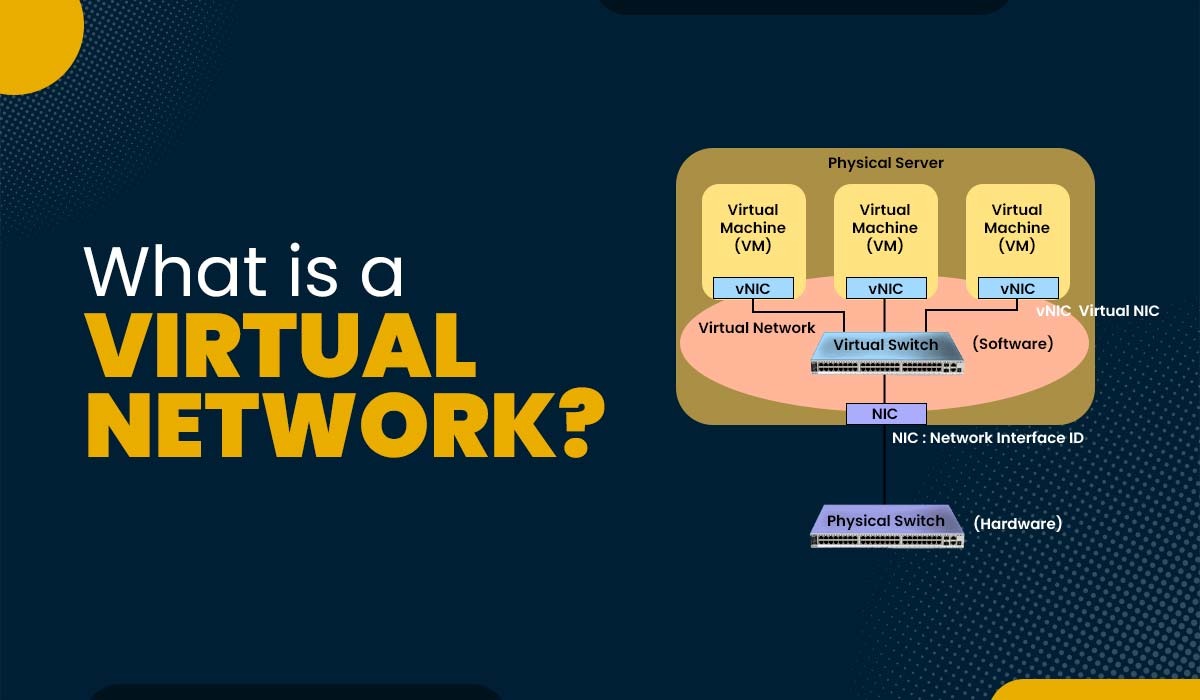Introduction
Virtual networks have gained popularity and significance in the field of computing and communication. They offer users the ability to create and manage networks that are independent of the physical infrastructure, such as routers, switches, cables, and servers. It can also isolate and segment traffic from different sources or destinations based on rules and policies. In this blog, we will discuss the virtual network, how it works, its types, and advantages.
Before getting into more details, let’s first understand a virtual network.
What is a Virtual Network?
A virtual network is a network that is created and controlled by software rather than relying on physical hardware. It allows various devices like computers, servers, routers, switches, and firewalls to communicate with each other as if they were directly connected by wires or cables. However, in reality, these devices are interconnected through virtual links that utilize the underlying physical network infrastructure.

A crucial element within a virtual network is the virtual network interface card (VNIC). VNIC works as a software simulation of a physical network interface card (NIC). It enables devices to connect with the virtual network. VNIC can effortlessly send and receive data packets over the network with the help of its own MAC address.
Another significant component of it is the machine (VM). It acts as a software emulation of a physical machine running an operating system along with applications. A VM can be equipped with one or multiple Virtual Network Interface Cards (VNICs), enabling it to establish communication with VMs or devices within the different virtual networks.
For a better understanding, let’s compare the physical network and virtual network.
Physical Network vs Virtual Network
Below we have compared both networks in a tabular form based on different factors.
| Factors | Physical Network | Virtual Network |
|---|---|---|
| Hardware | Requires physical hardware such as cables, routers, switches, and servers | Requires minimal hardware such as a host server and a physical NIC |
| Software | Requires less software such as drivers and protocols | Requires more software such as vSwitch, network adapter, firewalls, and security |
| Connectivity | Connects computers and devices through cabling and other hardware | Connects computers and virtual machines through software and wireless technology |
| Management | Requires more manual configuration and maintenance of hardware | Requires more software-based configuration and management of network services |
| Flexibility | Less flexible and scalable as it depends on the availability of hardware resources | More flexible and scalable as it can create multiple virtual networks on a single physical network |
Now that we have a basic understanding of these networks, let’s discuss how it works.
How Virtual Networking Works?
It operates by utilizing software to generate and oversee network packets, which are the data units that traverse a network. These packets are enclosed with information, like source and destination addresses, and are further directed by either software switches (vSwitch). These switches or routers can be devices or virtual devices running on a host computer.
The host computer, being a device, runs one or more VMs (Virtual Machines) and VNICs. It can also have NICs (Network Interface Cards) that connect it to other physical networks. To create and manage the VMs and VNICs, the host computer utilizes a software layer called a hypervisor. Acting as a bridge between networks and physical networks, the hypervisor allows communication between them.
Hypervisor is a layer of software that runs on top of the hardware. It oversees the VMs and their VNICs while also having the capability to create and manage switches. These switches serve as software devices connecting VNICs within a network.

The hypervisor has the capability to incorporate network functionalities, like firewall, load balancing, NAT, VPN, and more. These functionalities can be implemented as software modules that operate on the switches or routers.
Classes of Virtual Networks
There are three classes of virtual networks, these are:
VPN (Virtual Private Network)
A VPN is a network or, let’s say, a connection that provides endpoint-to-endpoint security over the internet. It can be compared to a tunnel where every bit of information that flows through it is encrypted and thus saved from hackers or eavesdroppers.
VPN is frequently employed by an organization to enable its workers to conveniently gain access to the organization’s network from a distance. They are also employed by individuals who are seeking to keep their online activities from being traced or interfered with by other users.
VLAN (Virtual Local Area Network)
A VLAN is also a type of network that partitions a single physical network into many Virtual networks. This is done to enhance security, minimize the traffic in the network, and enhance flexibility.
VLANs are often used in large organizations to segment different departments or teams into separate networks. For instance, a firm may have VLAN dedicated to the finance or perhaps the marketing department. This is effective in ensuring that sensitive information is well-sorted and well-protected.
VXLAN (Virtual Extensible LAN)
It is to be noted that VXLAN creates a Layer 2 network over a Layer 3 infrastructure. VXLAN’s capability makes it possible for devices within the same VXLAN segment (or VNI) to communicate as if they reside in the same physical network irrespective of their actual physical location. VXLAN operates over an IP network, allowing Layer 2 frames to be encapsulated within Layer 3 UDP packets for transport.
VXLAN is often used in large data centers and especially in cloud-based solutions in order to build networks where the VXLAN overlay networks are spread across different physical networks. It fulfils the basic purpose of traffic filtering and network segmentation, which further enables network virtualization.
Use Cases of Virtual Networks
However, to provide a clearer picture of Virtual Networks, below are the possible use cases.
- Mergers and acquisitions: Utmost compatibility of new networks in the current or existing infrastructure.
- Disaster recovery: Helps in specifying the option for switching the network quickly if there is an unfavorable event, such as a disaster.
- Network isolation: Isolate sensitive networks or devices from the rest of the network for security.
- Network extension: Assist in connecting a remote branch or some other, i.e., remote location, to the company’s network.
- Multi-tenancy: Allows multiple organizations to use the same network, but still the data in each organization’s network will be independent of the other. This is known as network isolation.
- Traffic management: Reduce network congestion by isolating high-traffic areas.
Let’s discuss the different types of virtual networks in detail.
Types of Virtual Networks
There are different types of virtual networks depending on different purposes. Below, we have explained three types with examples.
Private Virtual Networks
These types of networks are mainly used by the devices that belong to them or have access to such types of networks. It creates a secure and isolated virtual environment in order to communicate or send sensitive data between applications. For example, an organization can use such types of networks in order to connect its different branches that are situated at different locations or sometimes to host its internal applications and databases.
Internal Virtual Networks
Now, the internal virtual networks are mainly for the devices that are part of the same server. It is used to divide as well as to organize the traffic and data. For example, an organization can use such type of network in the case when they want to separate their departments or teams. This will give them the opportunity to assign different permissions to different devices or users.
External Virtual Networks
An external virtual network is a type of network that is mainly accessible by users outside of a physical network. It is used to connect different networks or services over the internet. For example, an organization can use such types of networks in order to access cloud-based applications or maybe resources. Most of the time, companies use these networks to provide services to their customers or partners.
Advantages of Virtual Networks
It offers benefits for both users and network administrators, including:
- Enhanced Security: By employing encryption authentication, isolation, and segmentation techniques, it safeguards data and devices from access or attacks.
- Improved Performance: Utilizing optimization load balancing, caching, and compression techniques, it enhances the speed and quality of data transmission within the network.
- Increased Productivity: Collaboration, mobility, automation, and innovation are enabled by a virtual network to enhance the efficiency and effectiveness of work processes.
- Reduced Cost: By minimizing hardware usage, energy consumption, space requirements, and maintenance needs, it reduces both capital and operational expenses associated with the network infrastructure.
- Simplified Network Architecture: It is important to note that these networks help achieve an easy and simplified network architecture to manage and maintain.
- Reduced Downtime: The idea of the virtual network is to offer some level of redundancy so that the communication path is designed not to be congested, and the traffic is automatically rerouted in time of need.
- Faster Deployment: Virtual networking can be implemented rapidly, and the time required to establish a new networking environment is minimal.
Frequently Asked Questions
Q1. What are the three types of virtual networks?
The three types of virtual networks are: Private, Internal, and External Virtual Networks.
Q2. What are virtual network devices?
Virtual network devices are mainly the software components that are utilized to emulate the functionality of physical network devices such as routers, switches, etc. One can also configure as well as manage them like real devices. These devices provide more functionalities and scalability than physical devices.
Q3. What are the uses of virtual network?
There are various uses associated with virtual networks. Some of these are:
- Reducing cost: In the case of physical equipment, there is high usage of cables, hubs, and many other components that increase the overall cost. But in the case of this network, fewer components are required.
- Centralized Access Control: One can easily access as well as manage these networks from a single device or computer.
Q4. What is a virtual network in cloud?
A virtual network in the cloud is a logical network that connects virtual machines and other resources in a cloud service provider’s data center.
Conclusion
In this blog, we have explained the virtual network in detail. We have also compared it with physical network. Apart from that, we have explained the workings of it along with its advantages.
If you want to learn more about it, you should move to ENCOR 350-401 Training.





